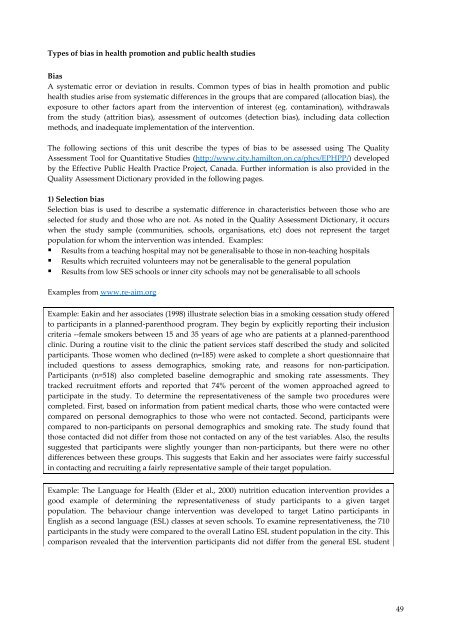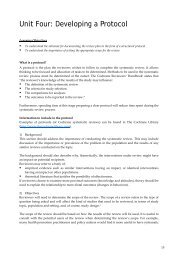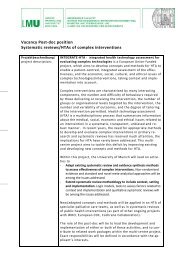Unit Eight: Principles of Critical Appraisal - Cochrane Public Health ...
Unit Eight: Principles of Critical Appraisal - Cochrane Public Health ...
Unit Eight: Principles of Critical Appraisal - Cochrane Public Health ...
Create successful ePaper yourself
Turn your PDF publications into a flip-book with our unique Google optimized e-Paper software.
Types <strong>of</strong> bias in health promotion and public health studies<br />
Bias<br />
A systematic error or deviation in results. Common types <strong>of</strong> bias in health promotion and public<br />
health studies arise from systematic differences in the groups that are compared (allocation bias), the<br />
exposure to other factors apart from the intervention <strong>of</strong> interest (eg. contamination), withdrawals<br />
from the study (attrition bias), assessment <strong>of</strong> outcomes (detection bias), including data collection<br />
methods, and inadequate implementation <strong>of</strong> the intervention.<br />
The following sections <strong>of</strong> this unit describe the types <strong>of</strong> bias to be assessed using The Quality<br />
Assessment Tool for Quantitative Studies (http://www.city.hamilton.on.ca/phcs/EPHPP/) developed<br />
by the Effective <strong>Public</strong> <strong>Health</strong> Practice Project, Canada. Further information is also provided in the<br />
Quality Assessment Dictionary provided in the following pages.<br />
1) Selection bias<br />
Selection bias is used to describe a systematic difference in characteristics between those who are<br />
selected for study and those who are not. As noted in the Quality Assessment Dictionary, it occurs<br />
when the study sample (communities, schools, organisations, etc) does not represent the target<br />
population for whom the intervention was intended. Examples:<br />
• Results from a teaching hospital may not be generalisable to those in non‐teaching hospitals<br />
• Results which recruited volunteers may not be generalisable to the general population<br />
• Results from low SES schools or inner city schools may not be generalisable to all schools<br />
Examples from www.re‐aim.org<br />
Example: Eakin and her associates (1998) illustrate selection bias in a smoking cessation study <strong>of</strong>fered<br />
to participants in a planned‐parenthood program. They begin by explicitly reporting their inclusion<br />
criteria ‐‐female smokers between 15 and 35 years <strong>of</strong> age who are patients at a planned‐parenthood<br />
clinic. During a routine visit to the clinic the patient services staff described the study and solicited<br />
participants. Those women who declined (n=185) were asked to complete a short questionnaire that<br />
included questions to assess demographics, smoking rate, and reasons for non‐participation.<br />
Participants (n=518) also completed baseline demographic and smoking rate assessments. They<br />
tracked recruitment efforts and reported that 74% percent <strong>of</strong> the women approached agreed to<br />
participate in the study. To determine the representativeness <strong>of</strong> the sample two procedures were<br />
completed. First, based on information from patient medical charts, those who were contacted were<br />
compared on personal demographics to those who were not contacted. Second, participants were<br />
compared to non‐participants on personal demographics and smoking rate. The study found that<br />
those contacted did not differ from those not contacted on any <strong>of</strong> the test variables. Also, the results<br />
suggested that participants were slightly younger than non‐participants, but there were no other<br />
differences between these groups. This suggests that Eakin and her associates were fairly successful<br />
in contacting and recruiting a fairly representative sample <strong>of</strong> their target population.<br />
Example: The Language for <strong>Health</strong> (Elder et al., 2000) nutrition education intervention provides a<br />
good example <strong>of</strong> determining the representativeness <strong>of</strong> study participants to a given target<br />
population. The behaviour change intervention was developed to target Latino participants in<br />
English as a second language (ESL) classes at seven schools. To examine representativeness, the 710<br />
participants in the study were compared to the overall Latino ESL student population in the city. This<br />
comparison revealed that the intervention participants did not differ from the general ESL student<br />
49








